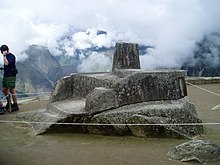From Wikipedia, the free encyclopedia
This article is about the archaeological site in the Machupicchu District, Urubamba Province, Cusco Region, Peru. For other uses, see
Inti Watana .
Inti Watana or Intiwatana (Quechua )[ 1] [ 2] Machu Picchu (Machu Pikchu) is a notable ritual stone associated with the astronomic clock or calendar of the Inca in South America . Machu Picchu was built c. 1450 by the Sapa Inca Pachacuti as a country estate.[ 3] [ 4] Viceroy Francisco de Toledo and the clergy destroyed those inti watana which they could find. They did so as they believed that the Incas' religion was a blasphemy [ 5] inti watana could be a political liability. The inti watana of Machu Picchu was found intact by Bingham in 1911, indicating that the Spanish conquerors had not found it.[ 6]
Design
The inti watana of Machu Picchu was carved at the top of a natural pyramid's summit. It is characterized by odd shapes which defy interpretation, and incomplete descriptions of its purpose in Inca chronicles.[ 6] [ 7] [ 8]
Inti Watana
Function
Possibly used as a sundial,[ 9] winter solstice .[ 10] archaeologists disagree, observing that the base is squat and stubby whereas the Tawantinsuyu is long and thin.[ 10] [ 11] [ 12] Pedro Sueldo Nava describes the landmark as "perhaps one of the most beautiful and enigmatic places to be found in Machu Picchu."[ 13]
See also
References
^ Teofilo Laime Ajacopa, Diccionario Bilingüe Iskay simipi yuyayk'ancha, La Paz, 2007 (Quechua-Spanish dictionary)
^
Diccionario Quechua - Español - Quechua, Academía Mayor de la Lengua Quechua, Gobierno Regional Cusco, Cusco 2005 (Quechua-Spanish dictionary)
^ http://www.destination360.com/south-america/peru/machu-picchu-history ^ http://www.britannica.com/EBchecked/topic/437494/Pachacuti-Inca-Yupanqui ^ Amao, Albert (23 January 2012). The Dawning of the Golden Age of Aquarius ISBN 978-1-4685-3753-6 . Retrieved 19 July 2012 . ^ a b Krupp, E. C. (5 August 2003). Echoes of the Ancient Skies: The Astronomy of Lost Civilizations ISBN 978-0-486-42882-6 . Retrieved 19 July 2012 . ^ Blacker, Maryanne (1 September 2010). DK Eyewitness Travel Guide: Peru ISBN 978-0-7566-8326-9 . Retrieved 19 July 2012 . ^ http://www.slideshare.net/sechariasitchin/zecharia-sitchin-the-lost-realms ^ Amao, Albert (24 January 2012). The Dawning of the Golden Age of Aquarius: Redefining the Concepts of God, Man, and the Universe ISBN 978-1-4685-3752-9 . Retrieved 16 July 2012 . ^ a b Jenkins, Dilwyn (1 October 2003). Rough Guide to Peru ISBN 978-1-84353-074-9 . Retrieved 16 July 2012 . ^ http://www.worldisround.com/articles/349341/photo72.html ^ http://coloradocollege.edu/dept/an/TorresRouff/AN203/AN203trigilio/index.htm ^ Nava, Pedro Sueldo (1976). A walking tour of Machupicchu . Retrieved 16 July 2012 .
Acaray Ahuila Gencha Machay Amaru Marka Wasi Arhuaturo Asana Asiru Phat'jata Aspero Auga Punta Auquilohuagra Awkin Punta Awkimarka (Apurímac) Awkimarka (Huánuco) Aya Muqu Ayamachay Ayawayq'u Azángaro Baths of Boza Bandurria Buena Vista Cahuachi Cajamarquilla Cao Viejo Carachupa Carajía Caral Caves of Sumbay Cerro Baúl Cerro Pátapo Cerro Trinidad Chacamarca Chan Chan Chanquillo Chauchilla Cemetery Chavín de Huantar Chawaytiri Cheqollo Chichakuri Chipaw Marka Choquepuquio Choquequirao Choquequirao Puquio Churajón Chuya Cochabamba Cochapata Colcampata Collor Condorcaga Cota Coca Coricancha Cumbemayo Cutimbo El Brujo El Cañoncillo El Ingenio El Paraíso Garagay Gran Pajatén Gran Vilaya Guellayhuasin Guitarrero Cave Hatun Machay Hatun Misapata Hatun Rumiyoc Hatun Uchku Hatun Usnu Hatunmarka Honcopampa Huaca de la Luna Huaca del Dragón Huaca del Sol Huaca Huallamarca Huaca Prieta Huaca Pucllana Huaca San Marcos Huaca Santa Ana Huacramarca Hualpayunca Huamanmarca, La Convención Huamboy Huankarán Huaycán de Pariachi Huánuco Pampa Huari Huayna Picchu Huayrapongo Huchuy Qosqo Huiñao Inca Uyo Incahuasi, Lima Ingatambo Inka Mach'ay Inka Raqay, Apurímac Inka Raqay, Ayacucho Inka Tampu, Huayopata Inka Tampu, Vilcabamba Inka Tunuwiri Inka Wasi, Ayacucho Inka Wasi, Huancavelica Inkapintay Inkilltambo Inti Punku Inti Watana, Ayacucho Inti Watana, Calca Inti Watana, Urubamba Intikancha Intini Uyu Pata Intipa Ñawin Intiyuq K'uchu Iskuqucha Isog Jinkiori Jisk'a Iru Muqu Kanamarka Kanichi Kenko Killa Mach'ay Killarumiyuq Kotosh Kuelap Kukuli Kuntur Wasi Kunturmarka, Ayacucho Kunturmarka, Pasco Kuntuyuq Kusichaka valley Khichuqaqa Khuchi Mach'ay K'allapayuq Urqu K'ipakhara La Otra Banda Laguna de las Momias Lauricocha Caves Layzón Llactan Llamachayuq Llamachayuq Qaqa Llamayuq Llamuqa Llaqta Qulluy, Acoria Llaqta Qulluy, Conayca Llaqta Qulluy, Tayacaja Llaqta Qulluy, Vilca Llaqtapata Machu Colca Machu Picchu Machu Pirqa Machu Pitumarka Machu Q'inti Mallkuamaya Mameria Maray Qalla Marayniyoq Marcahuamachuco Markahirka Markansaya Markapukyu Marpa Mawk'allaqta, Castilla Mawk'allaqta, Espinar Mawk'allaqta, La Unión Mawk'allaqta, Melgar Mawk'allaqta, Paruro Mawk'allaqta, Sandia Mawk'ataray Mazur Miculla Millka Miraflores Mirq'imarka Miyu Pampa Molloko Moray Mulinuyuq Mullu Q'awa Muyu Muyu Muyu Urqu Muyuq Marka Nazca Lines Nina Kiru Ninamarca Ñawpallaqta, Huanca Sancos Ñawpallaqta, Fajardo Ñawpallaqta, Lucanas Ñusta Hispana Ollantaytambo Pacatnamu Pachacamac Pachatusan Paiján Pañamarca Paracas Candelabra Paraccra Patallaqta Pikillaqta Pikimach'ay Pilluchu Pinkuylluna Pirca Pirca, La Libertad Pirca Pirca, Lima Pirhuaylla Piruro Pirwayuq Písac Puka Pukara Puka Tampu Puka Urqu Pukara, Coporaque Pukara, Fajardo Pukara, Puno Pukara, Vilcas Huamán Pukarani Pumamarka, San Sebastián Pumamarka, Urubamba Pumaq Hirka Pumawasi Punkuri Puqin Kancha Puruchuco Purunllacta, Cheto Purunllacta, Soloco Pusharo Pusuquy Pata Puyupatamarca Qaqapatan Qenko Qillqatani Qillqa Qillqay Mach'ay Quiaca Quillarumi Quishuar Qullqapampa Qulu Qulu Qunchamarka Qunchupata Quri Winchus Qurimarka, Apurímac Qurimarka, Cusco Quriwayrachina, Anta Quriwayrachina, Ayacucho Quriwayrachina, La Convención Qasa Pata Qhapaq Kancha Raqch'i Revash Rumicolca Rumiwasi Runayoc Runkuraqay Sacsayhuamán Sara Sara Sayacmarca Sayhuite Sechín Sillustani Sipán Sóndor Soro Mik'aya Patjxa Susupillu Tambo Totem Tambomachay Tampu Mach'ay, Huancavelica Tampukancha Tanqa Tanqa Tantarica Taqrachullu Tarahuasi Tarmatambo Templo del Zorro The Toads of Wiraqucha Tikra Tinyaq Tipón Titiqaqa Toquepala Caves Toro Muerto Trinchera Túcume Tunanmarca Tunay Q'asa Tupu Inka T'akaq T'uqu T'uquyuq Uchkus Inkañan Urpish Uskallaqta Usnu, Ayacucho Usnu, Huánuco Usnu Muqu Usqunta Uyu Uyu Venado cautivo Ventanillas de Otuzco Ventarron Vilcabamba Vilcashuamán Viracochapampa Vitcos Waman Pirqa Wamanilla Wamanmarka, Chumbivilcas Wamanmarka, Lima Wanakawri, Cusco Wanakawri, Huánuco Waqlamarka Waqra Pukara Waqutu Warahirka Waraqayuq Waraqu Urqu Warawtampu Wari Willka Waruq Wat'a, Cusco Wat'a, Huánuco Wayna Q'inti Wayna Tawqaray Wichama Wichqana Wich'un Wila Wilani Wilca Wilcahuaín Willkaraqay Wiñay Wayna Wiraqucha Pirqa Yanaca Yanaqi - Qillqamarka Yaynu Yuraq Mach'ay


